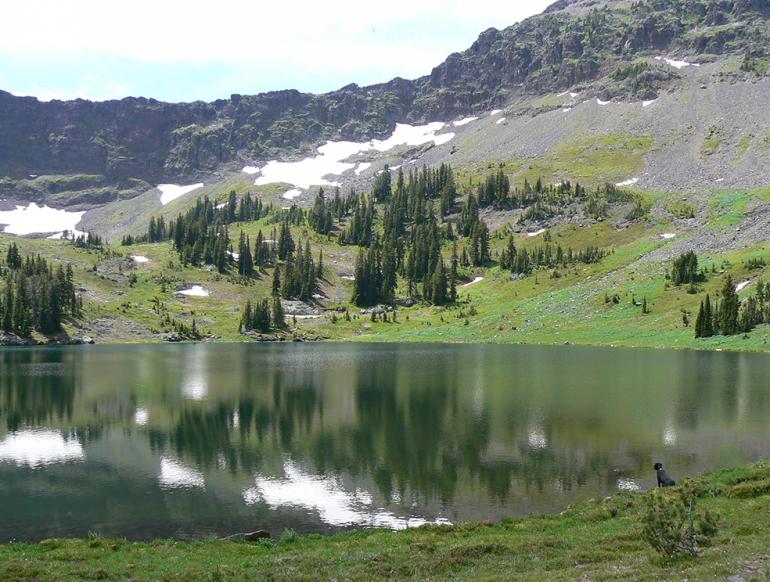Roadless Areas
And what they mean to Montana.
On a mid-April day with deceivingly spring-like weather, I went running on a dirt road about 10 miles outside Bozeman. My original plan had been to drive to a trail in the foothills of the Bridgers, but seeing that that road was a veritable bog, I realized that the trail at its terminus was likely snowed in.
So a smooth, dry ribbon of dirt just a few miles away would have to suffice. I ran alongside a backdrop of snowy peaks and velvety brown fields—a scene that would have sparked envy amongst my urban-dwelling friends on the East Coast. But the fact of the matter is, the road may have gotten me the vista, but what I really wanted was to be off-road altogether, climbing up into those mountains and away from the exhaust fumes and mile-marker signs.
It goes without saying that roadless areas are the places most cherished by outdoorspeople. In official terms, roadless areas are parcels of National Forest, BLM, Park Service, and U.S. Fish & Wildlife land. They're Montana's wildlife corridors, trout streams, mountain ranges, and hunting grounds. They're different from designated wilderness areas in that they allow for motorized and mechanized vehicles, chainsaws, mining. But oftentimes, they're both adjacent to wilderness areas and pristine enough to qualify as wilderness.
In the nineteenth century, the American landscape was largely roadless. Today, only ten percent of Montana is without roads—a high number in comparison with other lower-48 states, but a shockingly small amount of land when you look at a map of the state. Montana's 9.4 million roadless acres are dwindling along with the rest of the country's 58.5 million acres because an initiative to protect them was shelved indefinitely by the Bush administration.
It's an issue that's been on the table since the Nixon presidency, when roadless areas were first inventoried. During the Clinton years, the National Forest Roadless Area Conservation Rule was drafted with the goal of protecting wildlands from new roads, logging, and energy development. The initiative received more public support and involvement than any other such policy under public review in U.S. history. Ninety-five percent of the 1.6 million Americans who voiced an opinion were supportive. The initiative had, in fact, already been signed by Forest Service Chief Michael Dombeck—the final step prior to enactment—when George W. Bush was inaugurated in January 2000 and promptly yanked it, claiming to want more public input on the issue.
Opponents to the initiative, including Montana Governor Judy Martz, claim that a freeze on road-building would reduce access to state lands. Not so, according to Alexandra Phillips of the Montana Wilderness Association. "That's a non-issue," she says. "Roadless areas have never cut off access." Moreover, mining and motorized access would not be affected by the initiative. "Some opponents say the Roadless Rule would be a new layer of protection—which they don't want," says Phillips. "They simply want the lands to be left the way they are, but with the increase in population and continued road-building by the Forest Service, these lands won't stay the way they are without protection."
A study by John Adams, chairman of the economics department of the University of Montana, shows that the initiative is in the state's economic interest. The study asserts that "travel and tourism provide more jobs and personal income than mining, wood and paper-products manufacturing, and agriculture." Tourism, Adams found, has a $1.5 billion impact on Montana's economy. The end of the road, it seems, is indeed the place to be. But until legal protection is instituted, roads will continue to gobble up Montana's wildlands at a rate of about 80,000 acres per year.
Roadless Montana by the Numbers
Number of Wildland-Related Tourism Jobs in Montana: 3,339
Number of Timber Industry Jobs That Would be Lost By the Roadless Initiative in Gallatin Valley: 3
Number of Timber Industry Jobs That Would Be Lost By the Roadless Initiative in Montana: 40
Mumber of Miles of Forest Service Roads in U.S.: 380,000
Number of Times Forest Service Roads Could Circle the Globe: 15
Number of Dollars Currently Needed to Repair Existing Forest Service Roads: 8.4 billion
Percentage of Montana Land With Roads: 86
Total Number of Miles of Roads in Montana: 90,000
Number of Montana Backcountry Trails Lost to Development Since 1945: 9,000
Number of Miles of Forest Service Roads in Montana: 32,900
Number of Those Miles Affected by Roadless Initiative: 0






